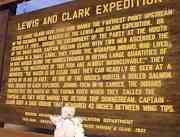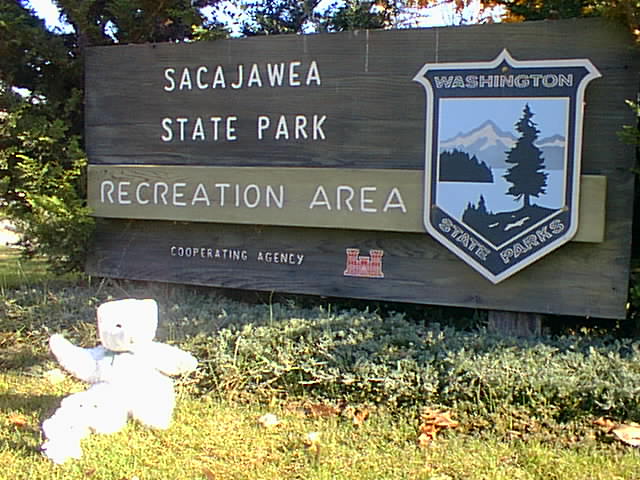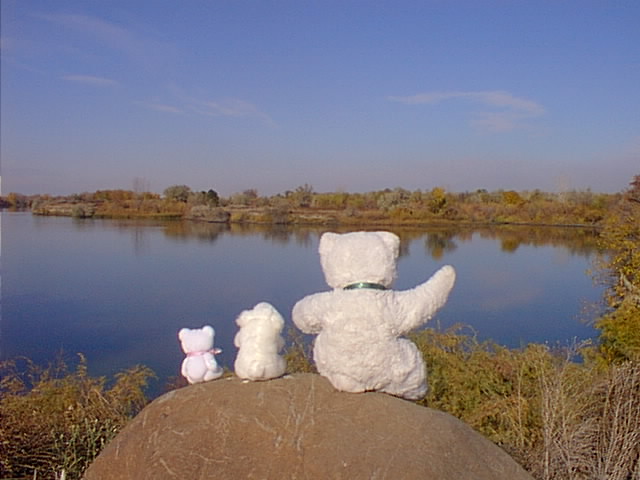On the Trail of Lewis and Clark
Perry follows the Corps of Discovery through his own back yard: the Mid-Columbia region of Washington state.
 It was a voyage of discovery! Nearly 200 years ago, Meriweather Lewis and William Clark led a brave band of explorers into the Western lands of North America. The expedition was called the Corps of Discovery. It would learn about the land, people and wildlife of the American West.
It was a voyage of discovery! Nearly 200 years ago, Meriweather Lewis and William Clark led a brave band of explorers into the Western lands of North America. The expedition was called the Corps of Discovery. It would learn about the land, people and wildlife of the American West.
Lewis and Clark's journey began on May 14, 1804. Three boats and nearly 40 men set out from a place near St. Louis, Missouri. Eighteen months later, the expedition would reach the goal: the Pacific Ocean. Along the way, the Corps of Discovery would make important discoveries and have exciting adventures.
Lewis and Clark's route took them right through our own back yard! Traveling down the Snake River to the mighty Columbia, the expedition camped at the place where the two rivers meet, now the city of Pasco. Captain Clark traveled up the Columbia to the mouth of the Yakima River in present-day Richland. He visited with Native Americans on Bateman Island, located in today's city of Kennewick. Traveling down the Columbia River to the ocean, the Corps of Discovery would pass the sites of other modern-day communities of the Mid-Columbia region.
This week, I set out on the trail of Lewis and Clark. With me were William and Merri, my newest bear brother and bear sister. William and Merri were named after William Clark and Meriweather Lewis. It was time for our new bears to learn about their famous namesakes.
"The object of your mission is to explore the Missouri river & such principal stream[s] of it, as, by it's course and communication with the waters of the Pacific ocean . . . may offer the most direct & practicable water communication across this continent."--Thomas Jefferson to Meriweather Lewis, June 20, 1803
 We prepared for our trip the way Lewis and Clark did: by reading and learning! William and Merri were very curious about Lewis and Clark, and the voyage of the Corps of Discovery.
We prepared for our trip the way Lewis and Clark did: by reading and learning! William and Merri were very curious about Lewis and Clark, and the voyage of the Corps of Discovery.
Our country's third president, Thomas Jefferson, commissioned Lewis and Clark's expedition. There were many reasons to explore the American West. Our nation had just bought the Louisiana Purchase: a huge tract of land reaching from the Gulf of Mexico to the border of present-day Montana. President Jefferson wanted to learn all he could about the new territory.
Captain Lewis studied many subjects to prepare for the journey. He learned about plants and animals. He studied medicine so that he could take care of his men. He read about geology, learned to make maps, and studied navigation. Captain Lewis met with many scientists and scholars to learn all he would need to know. He would perform most of the expedition's scientific tasks.
Captain Lewis made other preparations. He purchased food, supplies and equipment. He bought scientific tools for navigation, map-making and surveying. He shopped for medical supplies and medicines. Captain Lewis obtained "trade goods": gifts to be given to Native Americans along the way.
Captain Clark served as the expedition's engineer. As an Army officer, he had many skills valuable to the expedition. He took care of practical problems, and managed men and materials.
Clark selected members of the party. He needed good hunters and woodsmen, and men who had been frontier soldiers. A blacksmith traveled with the group to care for equipment. York, Clark's black slave, came along on the journey. All told, there were about 40 members of the expedition when it set off in 1804.
"The wife of Shabono our interpetr we find reconsiles all the Indians, as to our friendly intentions a woman with a party of men is a token of peace."Journal of William Clark, October 13, 1805
 Merri and William wiggled with excitement. We had reached our first stop on the trail of Lewis and Clark: Sacajawea State Park.
Merri and William wiggled with excitement. We had reached our first stop on the trail of Lewis and Clark: Sacajawea State Park.
The park is located off Highway 12, and lies at the junction of the Snake and Columbia rivers in Pasco.
Although the park was closed for the winter, we were able to walk to the park's monument. I read the words commemorating Sacagawea's contribution to Lewis and Clark's expedition. "I think our next Ewer bear should be named for Sacagawea!" said Merri.
Merri was right! Sacagawea was one of the most famous members of the expedition - and perhaps among the bravest. She was a very young Native American woman, and the only woman in the party.
The expedition spent the first winter of the journey at Fort Mandan, along the Missouri river about 50 miles northwest of present-day Bismarck, North Dakota. Several new members joined the Corps of Discovery that winter. Among them was a French Canadian trader, Toussaint Charbonneau. Charbonneau had lived among Native Americans and knew their languages and customs.
With him, came his wife, Sacagawea. She was about 17 years old. Sacagawea was a Shoshone. The local peoples had captured her when she was 13. That winter, Sacagawea had a baby boy, Jean Baptiste. Sacagawea carried the baby, known to the Corps as "Pomp", all the way to the Pacific Ocean on her back.
Lewis and Clark hoped that Sacagawea would help interpret when the expedition met other Native American peoples. Her presence proved to be very important. Because she and her baby were with the expedition, other Native Americans did not mistake the group for a war party.
"after getting Safely over the rapid and having taken Diner Set out and proceeded on Seven miles to the junction of this river and the Columbia . . . ."Journal of William Clark, October 16, 1805
 At Sacajawea State Park, William, Merri and I sat down at the water's edge. We watched the broad blue rivers as they met and mingled.
At Sacajawea State Park, William, Merri and I sat down at the water's edge. We watched the broad blue rivers as they met and mingled.
Sitting along the river, I wondered what the members of the Corps of Discovery had seen when they visited here.
Times had been difficult for the members of the expedition. During September 1805, the Corps of Discovery pushed through the rugged Bitterroot mountain range in Montana. Game was very scarce. Hunters were not able to kill enough deer to feed the travelers. Everyone was very hungry, and many were sick. To survive, the party slaughtered 3 colts from their own herd of horses, and ate their remaining food supplies.
Leaving the mountains for the prairie, the travelers reached the Clearwater River in Idaho. There, the expedition met the Nez Perce tribe - and food! Gifts of dried salmon, camas root bread and berries were greeted with delight. It had been a very difficult mountain crossing.
From this point, the expedition would travel by water. The Nez Perce taught Lewis and Clark how to make canoes, and agreed to keep the expedition's horses. Although many were still sick and weak, the expedition set off down the Clearwater and Snake Rivers.
On October 16, 1805, the expedition arrived at the Columbia River. The Corps of Discovery made camp at the site of Sacajawea State Park. They had reached the mighty Columbia, and spirits were high.
"I saw about 200 men comeing down from their villages . . .. after we built our fires of what wood we could collect, & get from the Indians, the Chief brought down all his men singing and dancing as they came, formed a ring and dancd for some time around us"Journal of William Clark, October 16, 1805
As they traveled down the Snake River, Lewis and Clark saw many Native Americans. People were fishing, preparing food, or swimming in the rivers. Now that camp was made, 200 members of the Wanapum tribe came to visit. The Wanapum village lay a quarter mile up the Columbia River.
The Wanapum came singing, dancing and beating on drums. Lewis and Clark smoked with the chiefs. They gave out medals and other gifts, and tried to explain by sign language that they were friendly, and came in peace.
Lewis and Clark would camp at this site for two days. They would scout the area, make scientific observations, meet with Native Americans, and purchase new food supplies.
"I took two men in a Small canoe and assended the Columbia river 10 miles to an Island near the Star[board] Shore . . . "Journal of William Clark, October 17, 1805
 William, Merri and I reached our next stop on the trail of Lewis and Clark: Wye Park and Bateman Island.
William, Merri and I reached our next stop on the trail of Lewis and Clark: Wye Park and Bateman Island.
The park is located on Columbia Drive in Kennewick. Pedestrians can reach the island by a causeway.
We stopped before a large sign at the park. The little bears listened eagerly as I read the story of Captain Clark's visit to the island. William was especially excited. He hoped to hear thrilling tales about his namesake!
One day after making camp, William Clark explored for about 10 miles up the Columbia River. Many Native Americans, who were curious to see what the visitor would do, followed his canoe.
William, Merri and I walked the short causeway from the park onto the island. How exciting to think that we were standing in the footsteps of the great explorer! We looked about, eager to see the plants and animals, birds and fish that Clark might have seen.
Bateman Island was a busy place! Clark had arrived at the end of the salmon's spawning season. In large mat lodges, everyone was busy splitting and drying fish. The Native Americans welcomed Captain Clark warmly, and fed him and his men some "delicious" boiled salmon.
The water of the river was clear and beautiful. Clark was astonished to realize that he could see salmon in the river at depths of 15 or 20 feet!
 William, Merri and I sat on a rock and looked at the river shore. Much has changed in the past 200 years. As people have come to our region, the environment has suffered. The water is no longer clear. Even though we looked very hard, we didn't see any salmon. The salmon are still there, but in smaller numbers. They are hard to see in the murky water.
William, Merri and I sat on a rock and looked at the river shore. Much has changed in the past 200 years. As people have come to our region, the environment has suffered. The water is no longer clear. Even though we looked very hard, we didn't see any salmon. The salmon are still there, but in smaller numbers. They are hard to see in the murky water.
Many people are working hard to preserve and protect our rivers. In the years to come, we will have to make many hard choices to try to save the salmon and their environment.
"we thought it necessary to lay in a Store of Provisions for our voyage, and the fish being out of Season, we purchased forty dogs . . . "Journal of William Clark, October 17, 1805
"Our diet extremely bad . . . all the Party have greatly the advantage of me, in as much as they all relish the flesh of the dogs."
Journal of William Clark, October 10, 1805
Lewis and Clark spent some of their time in the Mid-Columbia seeing to the expedition's food supplies. Captain Clark killed several sage grouse and ducks to supplement the men's diet. The expedition purchased dried salmon from the Native Americans.
The most usual food source: dogs. Dogs had been offered for sale as food ever since the Corps of Discovery met the Nez Perce tribe. Most of the travelers, weakened and hungry from the trek through the Bitterroots, enjoyed the new addition to their diet. Poor William Clark did not.
While camped at the site of Sacajawea State Park, Lewis and Clark purchased 40 dogs to sustain them on the last leg of their journey to the ocean.
Rested and refreshed from their two-day stay in the Tri-Cities area, Lewis and Clark's party moved on. On October 18, 1805, they guided their canoes through the Wallula Gap. The canyon was spectacular: a deep chasm in the desert with nearly vertical cliffs.
That night, the Corps of Discovery made camp just above the border with Oregon. The expedition had passed by a village of the Wallawalla. Lewis and Clark sent their guides to ask the chief to visit their camp. He did, accompanied by 20 men. The chief brought a large basked of mashed berries, and the parties exchanged gifts.
"I discovered a high mountain of emence hight covered with Snow, this must be one of the mountains laid down by Vancouver . . . "Journal of William Clark, October 19, 1805
 It was mid-afternoon. William, Merri and I had reached Crow Island, our last stop on the trail of Lewis and Clark. Leaving the Tri-Cities, we drove south and west to Crow Butte State Park.
It was mid-afternoon. William, Merri and I had reached Crow Island, our last stop on the trail of Lewis and Clark. Leaving the Tri-Cities, we drove south and west to Crow Butte State Park.
The park is located on an island in the Columbia River. Just off Highway 14, we drove along a causeway to the island.
Wind whipped at my fur. It felt cool and bracing. We settled on a log on the beach, and looked out across the wide gray span of the Columbia River. William enjoyed the cool breeze. Merri swung her head from side to side to smell the clean river scent.
Lewis and Clark had reached this island a day after they visited with the chief of the Wallawalla. In the morning, they said goodbye to their new friends. The canoes splashed into the waters of the Columbia. Too soon, the party hit a stretch of treacherous rapids. The canoes were lifted out and carried for two miles.
Most of the party helped transport the canoes and goods around the rapids. William Clark and a few others walked to a high bluff. There, Clark spotted Mount Adams. Captain Vancouver had described the immense mountain when he sailed to the mouth of the Columbia from the Pacific. The expedition had sighted their goal!
Looking across the river, Clark saw a village of Umatilla people, near the present-day town of Plymouth. He tried to visit them, but the village seemed empty. Clark pushed open the door of one of the lodges. Inside, the villagers crowded, crying and afraid.
Clark and his men tried to calm the Umatilla. They offered small gifts, but the villagers remained frightened and tense. Only the arrival of Sacagawea, Clark wrote, "confirmed those people of our friendly intentions, as no woman ever accompanies a war party of Indians in this quarter." Journal, October 19, 1805.
"In obedience to your orders we have penitrated the Continent of North America to the Pacific Ocean . . . ."Letter of Meriweather Lewis to President Jefferson, September 24, 1806
On the shores of Crow Island, William, Merri and I watched the late-afternoon sun sparkle on the water. William yawned. Merri leaned against me, and her eyes drifted shut. Soon, we would leave Lewis and Clark and the Corps of Discovery, and return to our home.
For the explorers, dangers remained. They would need to negotiate the treacherous rapids of The Dalles. Even when they reached the shores of the Pacific, the party would battle cold and rain and the coming winter to establish their winter camp at Fort Clatsop.
The trip home would be long and full of adventures. Back in the United States, many people had given up the expedition for lost.
On September 23, 1806, Lewis, Clark and the Corps of Discovery reached St. Louis. The entire town raced to greet the brave explorers with cheers. Soon, the whole young nation of the United States of America would ring with the news: the explorers succeeded! Lewis and Clark reached the Pacific!
Many changes would come to the lands where Lewis and Clark walked. Nearly 200 years later, our country spreads from shore to shore.
Many people would follow, but the deeds of the men who led the way will live in history forever.